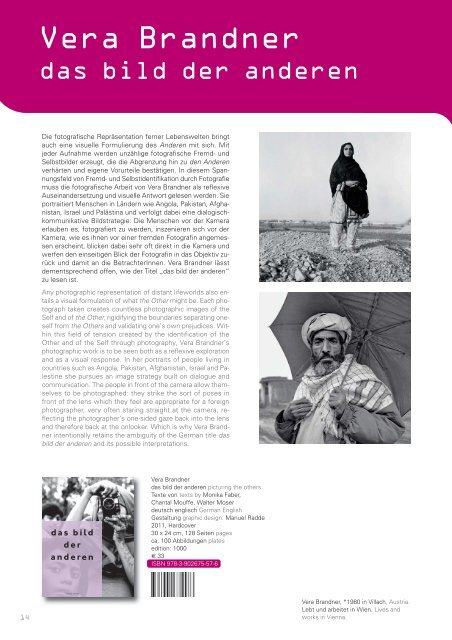(pdf), 3971 Kb - Fotohof
(pdf), 3971 Kb - Fotohof
(pdf), 3971 Kb - Fotohof
Erfolgreiche ePaper selbst erstellen
Machen Sie aus Ihren PDF Publikationen ein blätterbares Flipbook mit unserer einzigartigen Google optimierten e-Paper Software.
14<br />
Vera Brandner<br />
das bild der anderen<br />
Die fotografische Repräsentation ferner Lebenswelten bringt<br />
auch eine visuelle Formulierung des Anderen mit sich. Mit<br />
jeder Aufnahme werden unzählige fotografische Fremd- und<br />
Selbstbilder erzeugt, die die Abgrenzung hin zu den Anderen<br />
verhärten und eigene Vorurteile bestätigen. In diesem Spannungsfeld<br />
von Fremd- und Selbstidentifikation durch Fotografie<br />
muss die fotografische Arbeit von Vera Brandner als reflexive<br />
Auseinandersetzung und visuelle Antwort gelesen werden. Sie<br />
portraitiert Menschen in Ländern wie Angola, Pakistan, Afghanistan,<br />
Israel und Palästina und verfolgt dabei eine dialogischkommunikative<br />
Bildstrategie: Die Menschen vor der Kamera<br />
erlauben es, fotografiert zu werden, inszenieren sich vor der<br />
Kamera, wie es ihnen vor einer fremden Fotografin angemessen<br />
erscheint, blicken dabei sehr oft direkt in die Kamera und<br />
werfen den einseitigen Blick der Fotografin in das Objektiv zurück<br />
und damit an die BetrachterInnen. Vera Brandner lässt<br />
dementsprechend offen, wie der Titel „das bild der anderen“<br />
zu lesen ist.<br />
Any photographic representation of distant lifeworlds also entails<br />
a visual formulation of what the Other might be. Each photograph<br />
taken creates countless photographic images of the<br />
Self and of the Other, rigidifying the boundaries separating oneself<br />
from the Others and validating one’s own prejudices. Within<br />
this field of tension created by the identification of the<br />
Other and of the Self through photography, Vera Brandner’s<br />
photographic work is to be seen both as a reflexive exploration<br />
and as a visual response. In her portraits of people living in<br />
countries such as Angola, Pakistan, Afghanistan, Israel and Palestine<br />
she pursues an image strategy built on dialogue and<br />
communication. The people in front of the camera allow themselves<br />
to be photographed: they strike the sort of poses in<br />
front of the lens which they feel are appropriate for a foreign<br />
photographer, very often staring straight at the camera, reflecting<br />
the photographer’s one-sided gaze back into the lens<br />
and therefore back at the onlooker. Which is why Vera Brandner<br />
intentionally retains the ambiguity of the German title das<br />
bild der anderen and its possible interpretations.<br />
das bild<br />
der<br />
anderen<br />
fotohof edition<br />
Vera Brandner<br />
das bild der anderen picturing the others<br />
Texte von texts by Monika Faber,<br />
Chantal Mouffe, Walter Moser<br />
deutsch englisch German English<br />
Gestaltung graphic design: Manuel Radde<br />
2011, Hardcover<br />
30 x 24 cm, 128 Seiten pages<br />
ca. 100 Abbildungen plates<br />
edition: 1000<br />
€ 33<br />
ISBN 978-3-902675-57-6<br />
Vera Brandner, *1980 in Villach, Austria.<br />
Lebt und arbeitet in Wien. Lives and<br />
works in Vienna.






